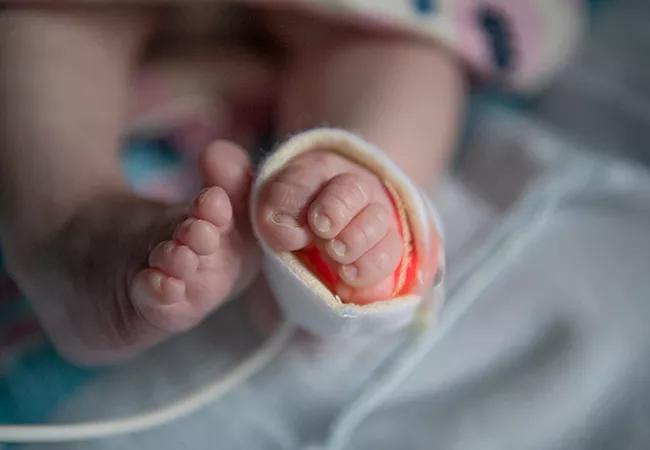Goal: Wean infants from opioids while their mothers start treatment

According to the latest report from the U.S. Centers for Disease Control and Prevention, 100,300 drug-overdose deaths occurred in the United States from May 2020 to April 2021, a 28.5% increase from the previous year.
Advertisement
Cleveland Clinic is a non-profit academic medical center. Advertising on our site helps support our mission. We do not endorse non-Cleveland Clinic products or services. Policy
Three-fourths of these deaths were attributed to opioids. These numbers reflect a rise in drug overdose deaths spurred by the COVID-19 pandemic that continues today. This uptick changed the trajectory of infants born addicted to narcotics, a condition known as neonatal abstinence syndrome (NAS).
“Enterprise-wide, we were down to 40 to 50 cases of NAS a year among 11,000 deliveries. In the last six to 12 months, that number has doubled,” says Jalal Abu-Shaweesh, MD, a neonatologist at Cleveland Clinic Children’s.
To help these infants and their families recover, Cleveland Clinic offers a comprehensive program that supports the babies through treatment for withdrawal, while encouraging their moms to undergo treatment themselves.
“We do not view addiction as a stigma, but as a problem that needs attention and treatment,” says Dr. Abu-Shaweesh.
NAS symptoms vary with the drug, dosage and length of use. The timing of symptom onset depends on the drug’s half-life.
“Illicit drugs like heroin, fentanyl and morphine have a short half-life, so symptoms appear 12 to 24 hours after birth,” Dr. Abu-Shaweesh explains. “Babies born to mothers taking drugs with a longer half-life may not show symptoms for two or three days.”
Symptoms may be present in varying degrees, or not at all. “In our experience, about 50% have enough symptoms to require treatment,” he says.
Symptoms usually begin with irritability and excessive crying and may progress to nausea, vomiting, sneezing, sweating and fevers.
“Many babies cannot be consoled by holding or feeding. They are jittery, can’t fall asleep or stay asleep and won’t eat well,” he says.
Advertisement
Without treatment, NAS infants are at risk for seizures. For this reason, Cleveland Clinic obstetricians (OBs) aim to identify patients who are using narcotics or are in treatment, so their babies can be observed in the NICU for a minimum of five days.
“If their symptoms are not excessive, they are unlikely to worsen, and the baby may be safely discharged,” says Dr. Abu-Shaweesh.
“However, if the mother goes home early, and her baby starts having symptoms, it is imperative she contact her pediatrician or come to the emergency department immediately, even if the initial symptoms are mild,” he emphasizes.
Although urine drug screenings can no longer be given without consent, Cleveland Clinic obstetricians remain alert for likely suspects for addiction and counsel them.“When a mom goes through acute withdrawal during pregnancy or delivery, they are actively managed, and our OBs attempt to get them into our opioid treatment program,” he says.
Treatment for NAS emphasizes nurturing, a decidedly low-tech but highly effective method. “Holding, cuddling and providing kangaroo care are more than adequate to get about half of these struggling infants through withdrawal,” says Dr. Abu-Shaweesh.
The other half require medical assistance to calm excited neurons in their brain. A starting dose of morphine is given and escalated, if necessary, until a dose that satisfies is reached. In some cases, up to three different medications are required. At the point symptoms are under control, the child is said to be “captured.”
Advertisement
“When captured quickly, a baby may respond very well,” says Dr. Abu-Shaweesh.
After 48 hours free of symptoms, the infant is stable, and the drug may be slowly withdrawn. The average weaning takes 16 to 20 days—although some cases have taken up to six weeks.
Babies who are unable to wean within the first five days are expected to have a long hospital stay. These families are offered the opportunity to have their stable infant transferred to Cleveland Clinic Children’s Hospital for Rehabilitation (CCCHR), where the treatment protocol can continue in an environment more conducive to recovery.
“We provide a private room and a low-stimulus environment, which allow the moms to sleep in and care for their babies. This arrangement is not possible in most NICUs,” says CCCHR Medical Director Michelle Marks, DO. “Family participation is essential in the management of these babies.”
As the babies recover, an extended stay at CCCHR gives moms the time and support they need to enter treatment themselves.
“Our team of occupational therapists, nurses and physicians are adept at caring for these infants, so the parents are comfortable leaving their babies with us while they work with social workers and government agencies to facilitate their own recovery,” says Dr. Marks.
After the infant has been weaned and is discharged, care continues in the NICU’s NAS Follow-up Clinic.
“There is some evidence that children affected by drug exposure in utero have sensory and developmental issues later. Participation in the Follow-up Clinic allows us to monitor their developmental needs,” says Dr. Marks.
Advertisement
Advertisement

Integrated care model reduces length of stay, improves outpatient pain management

A closer look at the impact on procedures and patient outcomes

Experts advise thorough assessment of right ventricle and reinforcement of tricuspid valve

Study also finds that 26% of children with cancer have mutations in DNA repair genes

A closer look at current uses and future opportunities

Experts are challenging the one-size-fits-all paradigm

Quality improvement project addresses unplanned extubation

Cardiac imaging substudy is the latest paper originating from the VANISH trial